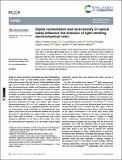Por favor, use este identificador para citar o enlazar a este item:
http://hdl.handle.net/10261/201071COMPARTIR / EXPORTAR:
 SHARE SHARE
 CORE
BASE CORE
BASE
|
|
| Visualizar otros formatos: MARC | Dublin Core | RDF | ORE | MODS | METS | DIDL | DATACITE | |

| Título: | Dipole reorientation and local density of optical states influence the emission of light-emittingelectrochemical cells |
Autor: | Jiménez-Solano, Alberto CSIC ORCID; Martínez-Sarti, Laura; Pertegás, Antonio; Lozano, Gabriel CSIC ORCID; Bolink, Henk J.; Míguez, Hernán CSIC ORCID | Fecha de publicación: | 7-ene-2020 | Editor: | Royal Society of Chemistry (UK) | Citación: | Physical Chemistry Chemical Physics 22(1): 92-96 (2020) | Resumen: | Herein, we analyze the temporal evolution of the electroluminescence of light-emitting electrochemicalcells (LECs), a thin-film light-emitting device, in order to maximize the luminous power radiated bythese devices. A careful analysis of the spectral and angular distribution of the emission of LECsfabricated under the same experimental conditions allows describing the dynamics of the spatial regionfrom which LECs emit,i.e.the generation zone, as bias is applied. This effect is mediated by dipolereorientation within such an emissive region and its optical environment, since its spatial drift yields adifferent interplay between the intrinsic emission of the emitters and the local density of optical states ofthe system. Our results demonstrate that engineering the optical environment in thin-film light-emittingdevices is key to maximize their brightness | Versión del editor: | http://dx.doi.org/10.1039/C9CP05505C | URI: | http://hdl.handle.net/10261/201071 | DOI: | 10.1039/C9CP05505C | E-ISSN: | 1463-9084 | Identificadores: | doi: 10.1039/C9CP05505C issn: 1463-9076 |
| Aparece en las colecciones: | (ICMS) Artículos |
Ficheros en este ítem:
| Fichero | Descripción | Tamaño | Formato | |
|---|---|---|---|---|
| c9cp05505c.pdf | 1,97 MB | Adobe PDF |  Visualizar/Abrir |
CORE Recommender
Page view(s)
155
checked on 23-abr-2024
Download(s)
158
checked on 23-abr-2024
Google ScholarTM
Check
Altmetric
Altmetric
Este item está licenciado bajo una Licencia Creative Commons

